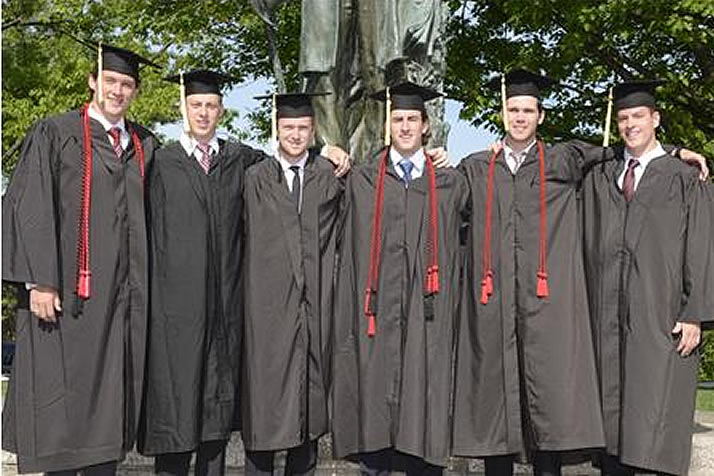Wednesday, May 27, 2015
Hockey Again Leads NCAA’s APR
Student-athletes’ success in the classroom highlighted in annual report.

The NCAA’s latest Academic Progress Rate (APR) data, released Wednesday, features men’s hockey as the nation’s No. 1 men’s sport in terms of student-athletes successfully progressing toward their degree for the second year in a row.
Men’s hockey’s four-year average APR score of 985 from 2010-14 is tied with fencing and water polo for the best mark of all men’s sports and leads all men’s sports with more than 22 programs (hockey has 59). Men’s hockey’s APR score is seven points above the NCAA average and a one-point improvement from last year’s score.
NCAA Release | NCAA Averages & Trends Report (.pdf)
“These NCAA statistics demonstrate again what exemplary young men are competing in Division I hockey today,” College Hockey Inc. Executive Director Mike Snee said. “Our student-athletes are not only pursuing their dreams of playing hockey at the highest level, but also simultaneously earning the degrees that will serve them so well for the rest of their lives. We couldn’t be more proud of their accomplishments both on and off the ice.”
The APR, created in 2003 to measure Division I schools and teams on their student-athletes’ success in the classroom, awards points to teams based on students’ grades, their progress toward their degree and for staying in school. Teams are also rewarded in the APR for students who return to school to complete their degree.
The APR is related – but not identical – to the NCAA’s Graduation Success Rate (GSR), serving in a way as a predictor of GSR success. Hockey also leads all men’s sports in the latest GSR data with a 92.1% graduation rate for student-athletes who enrolled in 2007.
Hockey’s single-year APR score for 2013-14 of 986 also shared the lead of all men’s sports with 50 or more programs (tied with golf). Hockey’s single-year eligibility rate (991) ranked first and its retention rate (979) ranked third.
The calculation of APR also rewards teams when former student-athletes return to school to complete their degree. In the 11 years since the introduction of the APR, 124 men’s hockey student-athletes have done so, including NHL players David Backes (Minnesota State), Nick Bjugstad (Minnesota) and Anders Lee (Notre Dame) in the past year. Calder Trophy candidate Johnny Gaudreau will be on campus at Boston College this summer to continue working toward his degree, while Torey Krug recently tweeted a picture of himself taking an online class in pursuit of his Michigan State degree.
“Earning my degree was something very important to me when I enrolled at Notre Dame and remained so once I signed an NHL contract after three years on campus,” said Lee, who ranked fourth among NHL rookies with 25 goals this season and graduated from Notre Dame last spring. “I’m grateful for the opportunity Notre Dame gave me to fulfill both of those goals – reaching the NHL and graduating from such a prestigious institution.”
Studying with a view! Slowly but surely working my way towards that degree from @MSU_Hockey !! #Santorini #Donkeys pic.twitter.com/uxzymGobFN
— Torey Krug (@ToreyKrug) May 21, 2015
Not only is hockey excelling on average as a whole, but each of the individual teams has demonstrated success. The NCAA penalizes teams with low APRs by banning them from postseason play of enforcing other limitations. Across all sports, 89 teams had APR scores below 930 and were subject to penalties, but none are hockey programs.
Five teams – Dartmouth, Merrimack, Princeton, Rensselaer and Robert Morris – had perfect four-year average APR scores of 1,000. More than 70 percent of all teams (43 of 59) had four-year APR scores of at least 980.
